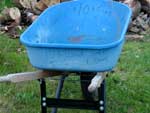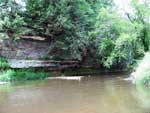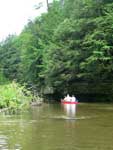A
previous
article showed how well
Polepunt
can work for a day trip on the sort of river where canoes work
well. It also has proved a good companion to camping. A backpacker
or experienced canoe camper could live in comparative luxury while
paddling down a scenic river. With a wife, two kids, and a big
dog I don’t travel that light, but it is still far lighter
than has been typical.
First let’s deal with some logistical details you’ll
want to know if you try this trip.
Wildcat Mountain State Park
Wildcat Mountain State Park is the place to camp. For being
in Wisconsin, it is quite reminiscent of the mountains in the
Eastern USA. Just not as high. It even has some switchbacks
on the state highway that gets you there, so take the speed
limit signs seriously. “15” truly does mean “15”
unless you’re on a motorcycle. I was shocked too.
Also watch yourself as you head up the road to the campground
– there are no guardrails. I guess they figure the trees
will stop you from rolling too far down. This isn’t such
a big deal going up, since it is hard to go very fast up a slope
that steep. But be sure your brakes can stop your trailer on
a steep downgrade!
Nice shady sites are 1, 4, 6, 7, 9, 14, 15. Tent pad at #1
gets some sun in the afternoon. These are all tent-only sites,
and mostly shaded. In fact the only tent-only sites I omitted
are 13 (much less shade) and 16 (in the middle of a roundabout,
which I don’t really like).
Here’s our site, which was #1.

There is a “scenic overlook” less than a half mile
down a trailhead right next to this campsite.


Try to make your trip in clear weather, too. This park is far
away from and high above any sources of light pollution. You
don’t have to get very far from the bathhouse lights before
the stars seem far brighter than usual. You can see many more
of them than normal, too. A map of the night sky is available
at the office for this reason.
Firewood
It is important to be aware that firewood may not be brought
in from outside of 30 miles surrounding the park, to prevent
the spread of harmful insect life and tree disease. Because
of this, firewood is available at the park office for $4 for
each rather small bundle. This is quite convenient because they
deliver it to your site, but is only available during office
hours.
You can get a better deal if you are willing to haul it a couple
miles up the road. At E13515 WI-33 you can get a large wheelbarrow
full for $10 any time of day or night. You just leave a $10
bill in the dropbox by the gatepost.


Sure it looks a little like Deliverance, but I didn’t
have exact change and happened to catch the proprietor cutting
wood (what else?). I didn’t catch his name, but he seemed
OK to me. More importantly, his business model is a boon to
campers in little boats. If you wind up wet and cold, it is
a great comfort to know you can get a lot of firewood any time
of day or night to warm yourself up and dry your stuff out.
There’s no comfort like sitting by a warm fire watching
the steam come out of your shoes.
Shuttling
Canoe trips on rivers nearly always involve a shuttle. Of course
Polepunt can be poled upstream, but it is obviously a lot more
work. Rivers that are “developed” for canoeing often
have shuttle service available for very reasonable fees. We
got our shuttle from Drifty’s Canoe Rentals, mostly because
they were the first place we came to, and the $15 they quoted
seemed reasonable.
Most folks rent a canoe, tell the outfitter where they want
to get out, and start paddling. Then the outfitter picks them
up at the appointed time and drives them and the canoes back.
We did this a little different.
The first several miles of the river wind through marsh and
farmland, much like creeks nearer where I live. I wanted to
spend my time among the cliffs, so we went from bridge 4 to
bridge 10.
We also did the shuttle all up front. I didn’t know how
long it would take us in the punt, since it is slower than a
canoe. And I didn’t want to have to wait for someone to
pick me up. So before even starting we dropped the boat at bridge
4, drove to bridge 10, and had the outfitter immediately return
us to bridge 4 to put in. This worked out quite well, but you
have to be sure of how far you want to go. There is no cell
phone signal at all in those valleys, and hardly any even at
the hilltops.
Actually that brings us to another thing worth mentioning.
All these canoe outfitters know each other. When we went back
to the river for some fishing at dusk, a large group of 20-somethings
was getting out two bridges too early. They asked if I could
give one of them a ride to where they were supposed to be (no
cell phone signal, remember?). I told them it wouldn’t
be a problem, but within the 5 minutes it took me to unload,
one of the competing outfitters pulled up and told them he’d
take them to meet their outfitter. People don’t spend
many winters out in the sticks without learning to help one
another.
One last point worth making is that it is quite possible to
shuttle yourself by bicycle. The climbs are fairly steep, but
the distances by road are very short compared to how far you
go on the meandering river. It is also near the Elroy-Sparta
bike trail, which goes through some interesting old rail tunnels.
Trip Time Revisited
We put in at 11:00 am and took out at 7:30 pm, making our total
travel time 8.5 hours. I figure stops for wading, resting and
making sandwiches amounted to around 1.25 hours, leaving 7.25
hours moving time. The distance by river from Bridge 4 to Bridge
10 is 8.1 miles, so we made an average speed of 1.1 mph. This
is pretty slow, but remember that this also includes winding
around shallow parts (more than 8.1 miles), dragging the boat
through riffles, jumping the boat over sunken branches, and
a lot of coasting along slowly to look at scenery.
I think the punt probably could make 2 mph over such a trip
if it wasn’t too hot and someone really wanted to move
fast. But you’d be better off in a canoe and better still
in a kayak if you want speed. Canoes passed us handily and kayaks
fairly flew by. The outfitters estimate the run to take 4.25
hours in a canoe, which is nearly twice as fast as the punt.
But Polepunt lets you do this trip carrying more people and
provisions, and if you travel as light as a canoe must, you
can get out and drag it a lot less often. And of course it is
a lot easier to move upstream when you can stand and pole with
little fear of capsize. And of course Polepunt is built to take
the bottom-dragging beating this river deals out.
Now that we have the details out of the way, on to the star
of the show.
The Kickapoo River
We put in at 11:00 am. Here’s the view upstream from
Bridge 4.

There was a bottom-scraping riffle right after the bridge,
and we had to pole backward to get to the deeper channel.

With some rain we’d have shot right through. The outfitter
said people had been making very good time because of a recent
rain, but the increase in flow level is very transient on this
river. Check out the
data. When there’s a rain, you get a quick
spike and then it’s gone. On the other hand, the river
never really dries up because it is largely spring fed. But
beware if it’s a big rain. Since the Kickapoo is largely
confined in a small canyon, it can only go up. Here are some
dead grasses washed into tree branches at standing head height.
One should not assume this little river is always little.

After a short straightaway…

…and a couple more small riffles, we are back into cliffs.


We even got some of the scenery in miniature.

Not far downstream we saw a lovely example of a bittern.

I had the opportunity for an even better photo, but it was
just as we were drifting under a rather active wasp nest. Silence
seemed prudent.
Shortly thereafter were some of the greenest plants I’d
ever seen. They were living in the shade, drinking directly
from seeps in the rock. Natural hydroponics, I guess.


You’ll notice that by this time the adults had shed their
lifejackets. We realized the river was almost entirely knee
deep or less, with only a few small holes. The kids kept theirs
on, given their affinity for dragging limbs in the water.

We saw the red canoes of the outfitters until the first bridge,
but we were completely alone.



The one exception was at bridge 7 where some locals were cooling
off, sitting in the shallow water in lawn chairs. I was too
busy chatting to get a photo, but here’s one from later
that evening of Colleen giving the kids some first fishing lessons
in the same spot. One hopes the setting makes a lasting impression.

We got several nice views of a heron, but he wasn’t too
interested in posing for a photograph. This is the best I could
do.

Other wildlife I failed to get good photos of were sandpipers,
kingfishers, and a number of smallish dragonflies with metallic
green abdomens. Absolutely spectacular, but they are small and
don’t hold still very long. (And I’m no Chartier-Bresson.)
Hopefully the landscapes make up for it.
Sometimes we could see a row of three or four cliff outcrops
all at the same time.

Or a fallen slab of rock with plant life still clinging tenaciously.

And there was an expanse of shoreline where the rock sloped
down into the water, the opposite of the undercutting that is
more common here.



Along the way there were several shallow caves. Not really
caves, I guess – just places where the water had worn
away the rock unevenly.


Looking up at one cliff, we noticed some interesting holes.
Most are cut away in layers.

And some of the landscapes speak for themselves more eloquently
than I can comment on them.
Near the end, we took the obligatory half hour stop for wading
and cooling off.

Final Thoughts
In any ways a canoe is better adapted to this river. Polepunt
is a compromise in that it serves other functions But it worked
well enough to do the job reasonably well, suffering only in
speed. Stay tuned for further explorations of those other functions.
Rob Rohde-Szudy
Madison, Wisconsin, USA
[email protected]
Click HERE for
a list of Articles and Columns by Rob Rohde-Szudy

